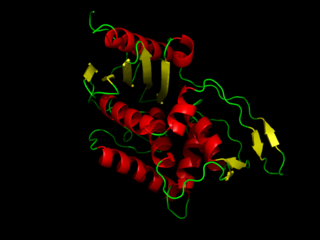
Coenzyme A (CoA, SHCoA, CoASH) is a coenzyme, notable for its role in the synthesis and oxidation of fatty acids, and the oxidation of pyruvate in the citric acid cycle. All genomes sequenced to date encode enzymes that use coenzyme A as a substrate, and around 4% of cellular enzymes use it (or a thioester) as a substrate. In humans, CoA biosynthesis requires cysteine, pantothenate (vitamin B5), and adenosine triphosphate (ATP).

DD-transpeptidase is a bacterial enzyme that catalyzes the transfer of the R-L-αα-D-alanyl moiety of R-L-αα-D-alanyl-D-alanine carbonyl donors to the γ-OH of their active-site serine and from this to a final acceptor. It is involved in bacterial cell wall biosynthesis, namely, the transpeptidation that crosslinks the peptide side chains of peptidoglycan strands.

In molecular biology, Beta-ketoacyl-ACP synthase EC 2.3.1.41, is an enzyme involved in fatty acid synthesis. It typically uses malonyl-CoA as a carbon source to elongate ACP-bound acyl species, resulting in the formation of ACP-bound β-ketoacyl species such as acetoacetyl-ACP.
In enzymology, a crotonoyl-[acyl-carrier-protein] hydratase (EC 4.2.1.58) is an enzyme that catalyzes the chemical reaction
In enzymology, an acyl-[acyl-carrier-protein]-UDP-N-acetylglucosamine O-acyltransferase is an enzyme that catalyzes the chemical reaction
In enzymology, a [acyl-carrier-protein] S-acetyltransferase is an enzyme that catalyzes the reversible chemical reaction
In enzymology, a [acyl-carrier-protein] S-malonyltransferase is an enzyme that catalyzes the chemical reaction
In enzymology, a beta-ketoacyl-acyl-carrier-protein synthase I is an enzyme that catalyzes the chemical reaction
In enzymology, a lipoyl(octanoyl) transferase (EC 2.3.1.181) is an enzyme that catalyzes the chemical reaction

In enzymology and molecular biology, a holo-[acyl-carrier-protein] synthase is an enzyme that catalyzes the chemical reaction:
Paromamine 6'-oxidase (EC 1.1.3.43, btrQ (gene), neoG (gene), kanI (gene), tacB (gene)) is an enzyme with systematic name paromamine:oxygen 6'-oxidoreductase. This enzyme catalyses the following chemical reaction
4-(gamma-L-glutamylamino)butanoyl-(BtrI acyl-carrier protein) monooxygenase (EC 1.14.14.13, btrO (gene)) is an enzyme with systematic name 4-(gamma-L-glutamylamino)butanoyl-(BtrI acyl-carrier protein),FMN:oxygen oxidoreductase (2-hydroxylating). This enzyme catalyses the following chemical reaction
Acetyl-S-ACP:malonate ACP transferase is an enzyme with systematic name acetyl-(acyl-carrier-protein):malonate S-(acyl-carrier-protein)transferase. This enzyme catalyses the following chemical reaction
Malonate decarboxylase holo-(acyl-carrier protein) synthase is an enzyme with systematic name 2'-(5-triphosphoribosyl)-3'-dephospho-CoA:apo-malonate-decarboxylase 2'-(5-phosphoribosyl)-3'-dephospho-CoA-transferase . This enzyme catalyses the following chemical reaction
2'-N-acetylparomamine deacetylase (EC 3.5.1.112, btrD (gene), neoL (gene), kanN (gene)) is an enzyme with systematic name 2'-N-acetylparomamine hydrolase (acetate-forming). This enzyme catalyses the following chemical reaction
L-glutamyl-(BtrI acyl-carrier protein) decarboxylase (EC 4.1.1.95, btrK (gene)) is an enzyme with systematic name L-glutamyl-(BtrI acyl-carrier protein) carboxy-lyase. This enzyme catalyses the following chemical reaction
γ-L-Glutamyl-butirosin B γ-glutamyl cyclotransferase is an enzyme with systematic name γ-L-glutamyl-butirosin B γ-glutamyl cyclotransferase . This enzyme catalyses the following chemical reaction
(Butirosin acyl-carrier protein)—L-glutamate ligase is an enzyme with systematic name (BtrI acyl-carrier protein):L-glutamate ligase (ADP-forming). This enzyme catalyses the following chemical reaction

Ketoacyl synthases (KSs) catalyze the condensation reaction of acyl-CoA or acyl-acyl ACP with malonyl-CoA to form 3-ketoacyl-CoA or with malonyl-ACP to form 3-ketoacyl-ACP. This reaction is a key step in the fatty acid synthesis cycle, as the resulting acyl chain is two carbon atoms longer than before. KSs exist as individual enzymes, as they do in type II fatty acid synthesis and type II polyketide synthesis, or as domains in large multidomain enzymes, such as type I fatty acid synthases (FASs) and polyketide synthases (PKSs). KSs are divided into five families: KS1, KS2, KS3, KS4, and KS5.





